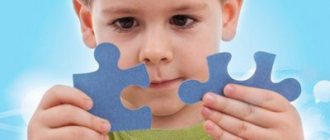Concept and description of the disease
Oligophrenia in children - photo:
Oligophrenia is a persistent mental underdevelopment. The disease develops during fetal development or during the postnatal period.
The disease belongs to the category of polyetiological ailments and can be provoked by the consequences of certain diseases of a woman before conceiving a child or during pregnancy, genetic abnormalities or the impact of adverse factors on the fetus.
Oligophrenia is considered one of the most complex diseases, practically untreatable. Timely treatment measures can significantly correct the child’s health status and facilitate his social adaptation.
Degrees
There are several stages and characteristics for mental retardation. Each form has its own characteristic differences. These include:
Initial. She is classified as mild mental retardation. In this case, the IQ level is from 40 to 70 points.
Average. This form is classified as moderate mental retardation. When passing the test of intellectual tests, the result ranges from 20 to 40%.
Severe imbecility. This degree is accompanied by a lack of intellectual thinking. The test taker's score ranges from 10 to 20 points.
Deep idiocy. Patients lack any signs of mental thinking and concentration.
Intellectual retardation is not amenable to drug and therapeutic treatment.
Causes and provoking factors
Numerous external and internal factors can provoke oligophrenia.
In some cases, specialists are unable to determine the specific factor that led to the development of the disease in the child.
Most often, doctors associate the manifestation of pathology with genetic predisposition (50% of cases in medical practice). The second most common cause of oligophrenia is considered to be prematurity.
In this case, there is underdevelopment of internal systems, which increases the risk of serious deviations in the development of the child.
The causes of oligophrenia include the following factors:
- fetal hypoxia during pregnancy;
- traumatic brain injuries sustained by a newborn;
- chromosomal abnormalities;
- infectious damage to the fetus;
- brain injury to a child during childbirth;
- genetic level disorders;
- chronic intoxication of the fetus with harmful chemicals;
- diseases that have a negative impact on the brain;
- critical lack of nutrients in the body of a pregnant woman;
- the child has other congenital mental disorders;
- asphyxia and birth injuries;
- a woman’s tendency to engage in bad habits during pregnancy;
- immunological conflict between the fetus and the woman;
- the presence of Rh conflict;
- infections of the genitourinary system in women.
How to determine microcephaly in a child? Read about it here.
Symptoms and signs
The most intense symptoms of oligophrenia manifest themselves in children when they reach the age of six .
Before this age period, signs of the disease can be recognized, but parents may mistake them for personality traits of the baby.
In addition, the severity of the disease directly depends on the location of the brain lesion . In some cases, symptoms of oligophrenia are detected at the stage of fetal development and in the first months of a small patient’s life.
Symptoms of the pathology depending on the age category of children:
- In newborns , the first signs of oligophrenia are considered to be excessive irritability, muscle weakness, a tendency to convulsive states, disproportion in the structure of the body, an increased size of the skull, other external defects (widely spaced eyes, “cleft lip”, too small size of the little fingers on the hands, flattened nose and faces).
- Children under one year old have a lack of interest in the world around them, contact with peers, they have difficulty understanding the speech of adults addressed to them, the developmental lag becomes more pronounced compared to their peers, children with mental retardation have difficulty reproducing words, repeating actions shown to them (external symptoms persist and become more severe).
- In a preschooler , symptoms of mental underdevelopment manifest themselves in a more pronounced form; children experience difficulties in performing simple tasks (drawing, modeling, and even manipulating toys) for a long time; there is a tendency to reproduce monotonous actions (a child can spend hours studying the same toy, try to understand the image in the picture, etc.).
- In a school-age child, the ability to recognize the properties of objects is impaired, they are characterized by chaotic activity, speech disturbances and distortion of received information occur, memory loss appears (kids need considerable time to remember basic actions), imaginative thinking may be completely absent, and the sense of empathy is significantly reduced.
What is the life expectancy of a child with Rett syndrome? Find out the answer right now.
Characteristics of mental retardation
Symptoms of this pathology include:
- Underdevelopment of motor skills.
- Severe speech impairments, difficulties in composing sentences.
- Slowness or complete absence of thinking.
- Poor spatial orientation.
- Strong excitability, or vice versa - inhibition.
- Poor memory and concentration.
Degrees and types of pathology
For a long time in medical practice, oligophrenia was divided into three types - debility, imbecility and idiocy.
This type of classification has been abolished. The priority has become the division of the disease into certain types in accordance with ICD-10.
As a basis, experts take intelligence indicators , which are a criterion for classifying a disease to a certain stage of pathology development.
Additionally, oligophrenia is divided into differentiated and undifferentiated forms. In the first case, the causes of the disease can be established, in the second, this possibility is not possible.
According to the degree of progression, the disease is divided into the following types:
- mild degree (intelligence index does not exceed 50-70 points);
- moderate form (maximum IQ reaches 35-50 points);
- severe stage (intelligence index does not exceed 25-30 points);
- deep type (intelligence level does not reach 20 points).
According to the etiology , oligophrenia is divided into pathologies caused by hereditary factors, intrauterine damage to the fetus, deviations in its development and birth injuries.
A separate category includes diseases caused by unspecified causes. Only a specialist can determine the negative factors that disrupt a child’s development based on a comprehensive examination of a young patient.
Diagnostics
One of the main stages of diagnosing oligophrenia is conducting psychological tests .
The doctor evaluates the speech and mental development of the little patient, his vocabulary, level of perception of the surrounding world and ability for abstract thinking.
Such techniques make it easy to identify the presence of pathology, but they can be used for children from the age of three. For young children, diagnosis is carried out in other ways.
When diagnosing the disease, the following methods :
- MRI of the brain;
- assessment of the child's memory;
- karyotype study;
- screening blood test for hypothyroidism and phenylketonuria;
- genetic testing;
- encephalography;
- comprehensive examination of the body;
- tests for congenital infectious diseases.
Moronism
This is a type of mild mental retardation, which is distinguished by the lowest degree of mental underdevelopment. The main feature of this disease is the loss of the ability to construct complex sentences, which does not allow the child to form abstract thinking.
Children have simplified thinking, as a result of which they can consider this or that event only superficially; the inner essence of situations is inaccessible to understanding by such children. Such a symptom greatly complicates adaptation in society.
Due to the fact that children's mechanical memory remains normal, they can study in regular schools, but they will need much more time to master the material. Significant difficulties arise in the study of technical sciences, in particular physics and mathematics.
Since such children lack the ability for creative activity, they try in every possible way to adopt the experience of those around them.
Such behavior can lead to the fact that sick children have a tendency to “teach”; they try to teach others what they themselves do not understand well enough.
There are even children with this type of disability (mental retardation) who are partially gifted - they have an absolute ear for music, have a unique memory, and draw beautifully.
Another symptom characteristic of such children is their excessive gullibility, so it is possible that people who do not have the purest intentions can take advantage of them.
Morons can have completely different characters: apathetic and overly active.
What does treatment include?
It is impossible to completely eliminate oligophrenia. Relative correction of the child’s condition is typical only for diseases identified at the earliest stages of development.
In other cases, children are prescribed symptomatic therapy and preventive procedures .
Classes with specialized specialists are an integral part of the treatment of pathology, regardless of its etiology, degree of progression and form.
in the treatment of oligophrenia :
- Taking tranquilizers (drugs from the group of sedatives, Diazepam, Phenazepam).
- Therapy with neuroleptics (medicines with antipsychotic effects, Nootropil, Relatin).
- Use of hormonal drugs (Hypophysin, Thyroidin).
- A course of herbal medicines to improve brain function and supply it with oxygen, as well as stabilize the central nervous system (Phesam, Piracetam, Pantocrine).
- Preventive therapy with vitamin complexes (special attention should be paid to replenishing vitamin B).
- Course intake of Glutamic acid (helps reduce the symptoms of mental retardation).
- Psychocorrection, psychotherapy and classes with a speech therapist.
- Exercise therapy and therapeutic massage (regular ten-day courses).
- Psychomotor gymnastics (it is better to entrust the procedure to a specialist).
Is Tourette's syndrome inherited? Find out about this from our article.
Rules for teaching retarded children
For mild mental retardation, the regular school curriculum can be followed. The child is able to master basic knowledge and adapt well to society.
You can keep your child busy with additional tutors, but at this point it is important not to overdo it and not cause stress and overwork in the child, which can aggravate the student’s mental state.
Children with moderate mental retardation can be educated in specialized schools or at home, and thus acquire all the necessary knowledge.
Such a child can independently carry out tasks such as sweeping or cleaning, and master the 3-4 grade curriculum of a regular school well.
Features of education
The behavior and attitude of parents towards a child diagnosed with oligophrenia are of particular importance for the therapy.
If the baby is raised in unfavorable conditions, the disease will develop at an accelerated pace.
The child will show signs of aggression towards the outside world, and the effectiveness of the rehabilitation course will be significantly reduced .
When raising a child with mental retardation, it is important for parents to remember several rules that must not be violated under any circumstances.
Parents are obliged:
- provide constant supervision of the child;
- provide the child with psychological assistance;
- treat the child kindly;
- positively motivate the child;
- teach the child basic skills;
- follow all recommendations prescribed by doctors;
- attend special classes with specialized specialists.
What's the forecast?
Favorable prognosis is possible only with early detection of oligophrenia in a child.
With timely treatment of mild illness, children gain the ability to perform basic everyday tasks.
As adults, they master certain types of professions well ; in some cases, a specially equipped workplace may be needed.
If oligophrenia progresses at an accelerated pace, then the child needs care throughout his life. It will be extremely difficult for him to carry out simple duties on his own.
Unfavorable prognosis for advanced mental retardation:
- lifelong intellectual disability;
- disability;
- pronounced mental disorders.










